|
Clue is wrapped up in a blanket because December is cold! But also because this is a wrap up and I like puns. Photo by Kate Ota 2021. After hitting my 30k goal during November, I decided to reflect on how well my prep in October helped with my writing process.
My project was an idea I’d had percolating on a back burner of my brain for a while. I kept little notes about it in a Word doc so I could keep track of what I’d thought about already. At the beginning of October, that Word doc was a mere two pages. I knew I needed to expand my idea into an outline, but was dissatisfied with 2020’s NaNo outline, which I had made using Save the Cat. That one had left me floating in Fun and Games (the bulk of Act 2 prior to the midpoint) and Bad Guys Close In (the bulk of Act 2 after the midpoint) with barely any idea of what was supposed to happen. I didn’t have time for that chaos this year, seeing as I was trying to do over half of the word count in under half the time. So, in 2021, I used another approach. I started with Save the Cat as a basic structure. Then I used The Story Equation to nail down character arcs because that tends to be my weak spot. That helped fill out the outline a little more. Then I used The Anatomy of Story to get into the rest of that outline’s details. This bulked up my plan significantly, especially in those pesky catch-all categories from Save the Cat (Fun and Games and Bad Guys Close In.) I ended October with thirty specific scenes in my outline. I knew this was not going to be the whole story, but it left enough wiggle room in between scenes that I could pants a little here and there. Gotta leave room for organic story growth and new ideas. As predicted, I ended up adding scene ideas as I went. Moments of “oh, he needs to be somewhere else, so let’s do a scene of where he went” and “gosh, I can’t believe I almost forgot this fun thing” got to be included while I also didn’t feel pressure to come up with something new on the spot each day. By the time I hit 30k (and ran out of time for NaNo) I hadn’t even gotten to the midpoint scenes! I think my outline hit just the right note between structure and freedom. A bit like a playground that has some abstract climbing equipment, allowing my imagination to frolic while giving it a jumping off point so it didn’t get exhausted. A more stringent outline might have forced me into doing one thing, and the slightest inspiration toward a new scene would have thrown off the whole plan, forcing me to choose the plan (and save myself a lot of trouble the rest of the month) or leap down the new rabbit hole of creativity (which could have led to a better story, or could have led nowhere.) Here are my tips for making your next NaNo (or drafting in any other month) more successful:
How did NaNo go for you? Did your prep help or hinder your final results? Let's discuss in the comments!
0 Comments
Like last year, I'm participating in NaNoWriMo, which will cut into my blogging time, so instead of fresh posts, I'll be updating my progress here. Unlike last year, I'm not doing a traditional NaNo. I have a job I commute to now and I have plans for Thanksgiving, so I know I won't have time to hit that 1667 words every day. Instead, my goal is to write all the scenes in my outline, about 30 scenes, so about 30k words. This will get me a zero draft from which I can expand and grow the story, which I find easier than the initial drafting. So! Without further ado, below are my updates for the month.
Started with: 8,433 words; 5 scenes Week 1 added: 19,361 words; 11 scenes Week 2 added: 10,746 words; 10 scenes Week 3 added: 0 words; 0 scenes Week 4 added: 0 words, 0 scenes Last two days of November: Final total after NaNoWriMo: In December I'll talk about how I prepped and what I felt worked and didn't work. Are you doing NaNoWriMo? Let's chat about it in the comments! Wilbur loved The Anatomy of Story so much, he kept rubbing his face against the cover. Photo by Kate Ota 2021 I picked up a copy of The Anatomy of Story by John Truby months ago and let it languish on my shelf. I thought I’d read once I was done editing my current project or maybe when I started querying. However, as I started prepping for NaNoWriMo (during which beta readers will have my current project) I realized I should take a look to see if this book would influence my Preptober.
Overview This approximately 400-page book is $18.99 for the paperback. It’s like going from Save The Cat and The Story Equation and taking the next step in writing mastery. It includes character creation, setting, theme, and twenty-two story beats. There are numerous examples throughout as well as worksheets. My Experience The story beats are a bit save-the-cat-ish, but those were hardly the best part of the book. I appreciated the analysis of character creation and scene setting that’s explained before plot gets brought up. The way different elements are discussed on a symbolic and thematic level was mind blowing. I even found I’d used some of the techniques on accident (probably from reading so much—hence why you need to read a lot!) and with some tweaking I could make it look very purposeful and deep. I hadn’t seen many of the major examples (Tootsie, Casablanca, and The Godfather were most referred to, and I hadn’t seen The Verdict either) but they were clearly explained. I had seen some others (It’s a Wonderful Life) so it was helpful that most concepts were explained using multiple examples. It’s a dense book. I tried to read it on my morning commute and fell asleep a couple times. You really need to be awake and committed to reading it. However, it’s dense with knowledge and supremely helpful. Is It Worth It? The price was great for the amount of information and length of the book, in my opinion. If you’re a person who likes to highlight and flag craft books, then the paperback is for you. If you aren’t a highlighting type of person, then go with the e-book version to save some money. I recommend this book if you’re looking to up your plotting skills. If you aren’t a plotter, I recommend a little more clear-cut plotting book first (like Save The Cat). It’s also not about basic sentence mechanics (for that I recommend It Was The Best of Sentences, It Was The Worst of Sentences) and while it covers character, I think you need a baseline of character building first (such as understanding want vs need; I recommend The Story Equation). I painted this wall during a mini-reno on my house. Why it's included will make sense by the end of the post. Photo by Kate Ota 2020 First drafts are often joked about and called things like dumpster fires or garbage drafts. They’re a way of getting ideas out of the writer’s head and onto the page. After all, you can’t edit something that doesn’t exist. First drafts will vary widely based on your writing methods. Plotters will have fewer problems than pantsers (usually), and some people would rather get it right on the first try than just get it down. However, with NaNoWriMo on the horizon, and many people about to write as many words as fast as they can, I thought I’d write about how I take problems spotted in the first draft and utilize them later.
Info Dumps A classic first draft problem, info dumps tell your reader all about the world or the character in one giant section. Not only is telling (vs showing) a potential issue, but info dumps ruin any tension that’s been built and slow the pace. Readers may end up skimming instead of absorbing the information. When you recognize an info dump as you edit, copy/paste it into another document where you keep your notes about the book (worldbuilding, names, etc.). I use Scrivener, so I have a whole folder where I keep this type of stuff. You can then bring back little chunks of info as they become relevant. I like to highlight sentences whose information I’ve added back, so I don’t accidentally repeat myself. Info dumps help you keep track of your world and get you into the mindset, so if you end up taking a break, you can read the info dump to get back into the manuscript. Dropping Characters Have you ever started a book with a cast of characters, but by the end you realize you haven’t mentioned one guy since chapter 4? Oops. It happens all the time. This means that character wasn’t as important as you initially thought. Maybe they aren’t needed at all, and you can take this mistake as a sign you should delete them all together. However, if they matter up front but clearly not later, you can also get rid of them in a way that adds to the story, such as acting as a red herring or increasing tension. Plot Holes Much like pot holes, plot holes make for a bumpy ride in a book. You should try to fill as many as you spot in your edits. However, rather than just filling a hole with the first thing that comes to mind, or the easiest thing to write, take the opportunity to dig a little deeper and see how you can enrich your world, characters, or plot while also filling the hole. It’s like those home renovation shows where they discover bad pipes and they say, “we could just replace the pipes in this bathroom, but eventually the whole house will need to have it redone, and if we do that, it means tearing out all that ugly paneling to get to the pipes behind it.” The wise choice is to rip out the paneling and replace all the pipes, if they have the budget. Since enriching your writing doesn’t cost money, go ahead and rip out the paneling. And the shag carpet, while you’re at it. Off Balance Scenes Some scenes will have too much narration, others will have too much dialogue. This is something you’ll want to balance out, but worry not. This mistake has actually highlighted for you what matters in that scene. Is it all about the dialogue? Then the narration you add in the next draft should be focused on the characters reacting to the dialogue and be less about stage direction. Is it all about narration? Then the dialogue you add shouldn’t be distracting from that and should instead voice the most important internal realizations. Underwriting Perhaps your first draft clocked in at about 60% of the expected word count for your age group and genre. This tells you that something is missing; characters, sub plots, setting or other descriptions, internal narration, etc. It will vary for each writer, but once you notice a pattern in where you skimp, you’ll know what needs to be added. For example, my early drafts lack emotions and reactions, so now I automatically put that in my editing to-do list. It may take more than one book to recognize where you could use more words, but once you know your first draft skinny points, you won’t even need to look to know they’re there. These can then become strengths of your next draft, since you’ll be putting conscious effort into adding these items. Overwriting The opposite of the last problem, if you overshoot your genre and age group’s expected word count, you’ll need to do a little cutting. Ideally, you won’t just delete, but keep removed scenes/paragraphs/sentences in another file for later. You can always come back to these and bring back little pieces to supplement the next draft. It’s easier to squirrel a scene away than it is to delete it, and you may find this strategy makes it emotionally easier to cut words. Identifying what to cut is harder, but if you compare your story’s beats to an established beat sheet (ex Save the Cat) you may be able to identify plot elements that take longer than expected and start hunting for what to cut there. The main benefit of overwriting is that it’s faster to cut than add words. Let's return to my home reno example from earlier. Basically, in a first draft you’re establishing what’s important. That’s setting the blueprint and foundation of the house. Building up the studs and deciding where walls go. First drafts are asking how big is the kitchen, how many beds and baths, is there a basement or a second floor. You don’t need to worry about which poster is going to hand above your desk in your home office. Sure, you can buy one if you see it and have it ready to hang, but the focus is going to be on bigger stuff first, by necessity. Yes, a home reno is messy with painter’s tape and loose nails and dust on everything. However, that’s because it’s not the final step yet. So don’t think of your first draft as garbage, think of it as the start of building a house. How do your first drafts go? Are you a plotter or a panster? Do you over or under write? Let's discuss in the comments! 1. Be lucky enough to find a regular time of day to write. Habits help.
2. Don't spend too much time on Twitter watching everyone else update their word counts and thinking about how you'll never get there. Or getting distracted by other things on Twitter. Or Facebook or YouTube, and maybe after you check all your emails, you'll get to writing... 3. Stop writing blog posts and get back to your NaNo project. 4. Shoo that cat off your lap so you can put your computer there. Except he's so cute and happy and he's purring. Okay, so maybe he can stay. Can you balance your computer one one hand and type with the other? 5. It's not moving the plot along, but it's a cute scene so write anyway. You can't kill your darlings later if you have no darlings. That's my method. What's yours? It's that time of year again! National Novel Writing Month! This year I registered on the website for the first time! I'm hoping to write 50k of a thriller. Possibly romantic thriller, we'll see. I'm still waiting to hear if I got into PitchWars (please please please!) but I figured that if I got very excited and into my NaNo project, that would tempt the universe to let me into PitchWars. Like when you're waiting for food at a restaurant and you decide to go to the bathroom, and that's when your food comes. Kind of. If I get into PitchWars, I'll happily drop this like a hot potato! (And store it in the fridge for later, I'm not a monster.) Bonus, if I don't get into PitchWars, maybe this project will distract me from the sting of rejection. As of now, my word count is 1803. Come be my friend on the NaNo site, I'm there as KateOta. (Wow so creative.) November is also National Eye Donation Month. Register as an organ, tissue, and eye donor if you haven't already! Also vote! (I did already!) [Update: Thanks for voting!] Man, November is jam packed. Will I manage 50k by 11:59pm on November 30th? I'll post weekly updates here, more updates on my twitter, and daily updates on NaNo's website. Week 1 Update: I haven't written yet today, but as of 11/7, my word count is 12,466! Staying on track! I didn't get into PitchWars, but that's okay. I'm going to let that manuscript sit for a bit while I finish NaNoWriMo and potentially get feedback from the mentors who requested my full. Week 2 Update: As of today, my word count is 28,402! I might make it! Week 3 Update: As of today, my word count is 40,832! Home stretch! Honestly, I don't know how people do this in ordinary years, with Thanksgiving travel and obligations and regular commuting work hours. Wizardry, probably. Final Update: Final word count: 50,096! It got tough in the home stretch because I "finished" what I'd outlined around 46k. I had to squeeze in a few more scenes (mostly in the Bad Guys Close In and Fun & Games sections, if you're familiar with the Save the Cat outline.) I honestly would not have finished at all without that detailed outline, so thankful I did that! I'm going to let it sit for a long time before I do any editing (and expanding to an appropriate length). And boy will it need a lot of work. While this is the fastest I've ever drafted, it's also my roughest first draft by far. Still, it was a worthy endeavor, and seeing the word count climb so fast was great. Not sure I'll be able to do it in a non-pandemic world (with Thanksgiving travel, possible commuting, social events, etc.) but hey, if one of the few good things about 2020 is that it made my first ever full NaNo worth it, I'll take it.
Did you participate? Did you hit your goal? Let's discuss in the comments! This the home page for One Stop for Writers. The image on the right changes. Overview:
One Stop for Writers is a website to help writers create characters and worlds and plot their novels. It’s powered by thesauruses, like the Emotion Thesaurus that I already decided is worth the price. Overall, the website offers fifteen thesauruses—all of the published ones and several others. At One Stop, you can create many different things to help you plan your novel. The Character Builder develops a personality, emotional wound, inner and outer motivations, fear, quirks, life, and physical traits. Character’s Fear is a similar page focused only on one character’s fear and what personality traits stem from that. Character Arc Progression asks for information from the Character Builder, but also has you consider a resolution. Emotional Progression has you lists events that occur and the emotions of the character, and how you plan to show (not tell) the emotions. Setting-at-a-Glance has you describe your setting with the five senses, as well as lighting/time of day. Emotional Value of a Setting adds symbolism and forces you to consider deeper aspects of scene that will theoretically reinforce the emotions of the characters. Scene Map (informal and formal) asks you for information about what is happening in the scene. The formal version asks more questions. The Story Map is a very general plot outline with major elements listed, generates an interactive imaged with acts 1-3 or stages 1-6 indicated. The timeline is great because you can write events as they come to mind, and then drag them around in whatever order you need. Last is the Worldbuilding Survey, which can be used to create planets down to a single household and everything in between. All of those have the thesauruses built in to offer suggestions that go together. For example, you select an emotional wound, and the website suggests fears that may stem from it. There are also worksheets and templates you can download to work offline, however these lack the connection to the thesauruses. The site also offers 47 checklists and tip sheets. Checklists can help you do things like add conflict or create a good flashback. Some of the lists include positive traits or when to show not tell. Many are also tutorials for how to use the various thesauruses, although that’s not very difficult. The website has excellent how-tos, including videos and screenshots. Most of it is very user friendly. There are cost tiers to consider. There’s a 2-week free trial, which you should absolutely use if you’re thinking of paying to play. Of note, with the free trial you cannot download pdfs of what you make and can only make one item in each category. It’s easy enough to get around those issues though, since you can copy/paste from the website into word and can delete info and remake subsequent items. I’m not being sketchy by telling you this, the website creators tell you that in the how-to-use section. Otherwise the pricing is: $9 for one month, $50 for 6 months, and $90 for one year. My Experience: I used my two-week free trial to work on the concept I had for a potential NaNoWriMo project. I’ve never done heavy outlining like this site offered, and thought the structure could be useful. Of the 15 electronic thesauruses, my favorite is symbolism thesaurus, because that’s my weakest skill. A few of them, like the texture thesaurus, were not very full, and I probably could have listed all of those entries myself. I enjoyed the character builder. It worked from the emotional wound outward, so that the character’s personality came together in an organic way. The suggests from the thesauruses were great and helped to easily build a round main character. However, if you have the print thesauruses, I think they’d cover the same information, though would be slower to navigate. Some of what you can make feels redundant, for example the Character’s Fear page is already something you fill out in the Character Builder. Perhaps it’s a short version meant for side characters. I decided to test if using this website helped me write a stronger first draft of a scene. I wrote the opening scene of my NaNoWriMo project after creating two characters, completing one Worldbuilding Survey, one Emotional Value of a Scene sheet, and a Story Map. Then I took this scene to my critique group. My critique group didn’t notice a drastic change in first draft quality from my previous WIP to this scene. They also didn’t pick up on any of the additions I made using the Emotional Value of a Setting sheet. I’ll admit that may be because I was not heavy handed with those suggestions. I did six hours of prep work on One Stop for Writers, but then I wrote 1000 words in a little over 30 minutes. Is It Worth It? If you are new to plotting, want to try plotting, or want to beef up your plotting, it’s a great resource. If you already have a plotting method that you love or if you are a panster for life, this won’t be terribly beneficial for you. I love that the site offers a free trial before getting pricey, because then you know what you’re paying for. If you’re willing to copy/paste and delete/redo then you can probably do all the planning you need during your free trial. It requires a lot of time to make what you need, but if you’ve got the time to use it, it’s fun. Overall, the free trial is for sure worth it. I don’t think the one-year trial is worth the price, unless you are an insanely prolific writer and constantly planning your next novel. The one-month trial may be helpful, but six months I can’t imagine being that useful. At least you can try it for free before beginning your next project. With one week left before NaNoWriMo begins, anyone needing help plotting may want to check this out now! Have you tried One Stop for Writers? Have you used a subscription? Did you think it was worth it? Let's discuss in the comments! I'm participating in NaNoWriMo . . . sort of. I'm doing an alternative version because I'm at that point in my WIP where I usually languish and struggle to keep going. Not this time! My goal is to add 20,000 words and get through the middle this month. If I hit 20k early, I'll up the count. And I'll post once a week to keep myself accountable.
Progress so far: Nov 1-3: 2,206 Nov 4-9: 7,145 Nov 10-16: 5,182 Nov 17-23: 6,658 Total so far: 21,191 I reached my goal! Woohoo! Now anything extra I write in November is just icing on the cake. Thanks for following my through my mini-NanNo adventure! |
Archives
April 2024
Categories
All
|


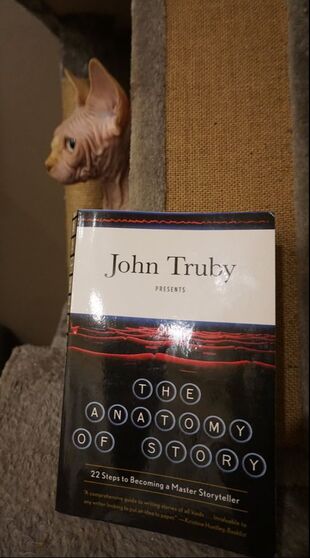


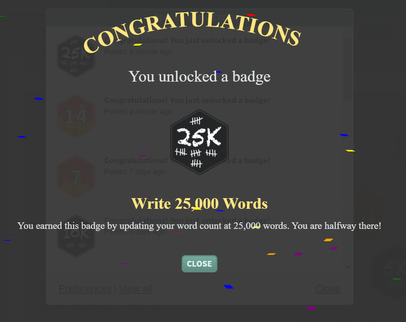
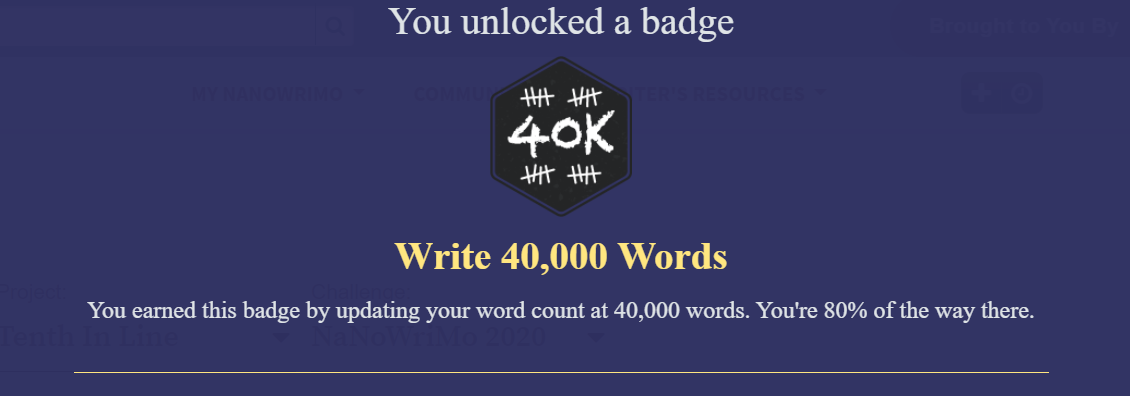
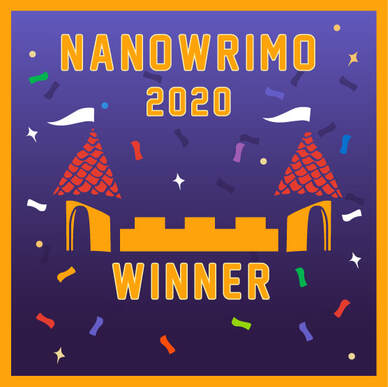
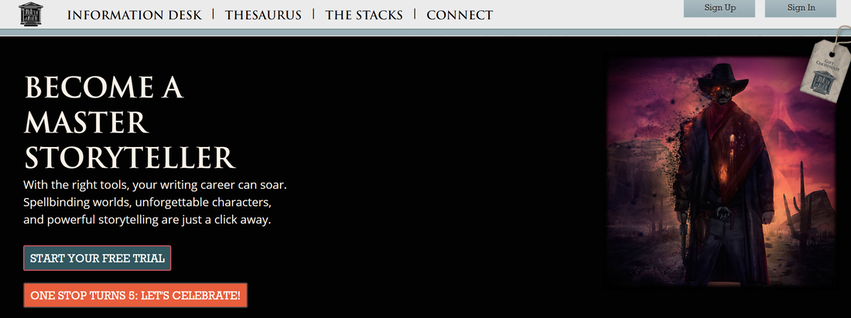
 RSS Feed
RSS Feed